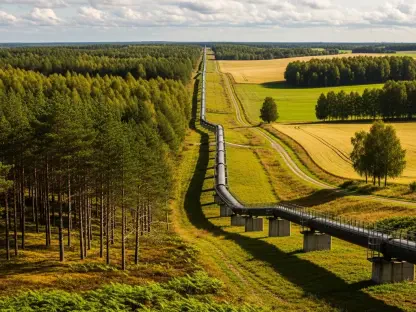The Environmental Protection Agency under the Trump Administration, spearheaded by Lee Zeldin, embarked on a controversial path of rolling back numerous environmental regulations, all in the name of promoting business growth. These policy shifts, covering climate change, air quality, water regulations, and enforcement practices, have sparked significant debate regarding the balance between economic expansion and public health. Critics argue that these rollbacks could jeopardize decades of environmental progress, while proponents claim they are necessary for reducing operational costs for businesses and lowering energy prices for American consumers.
Climate Change and Energy
Reassessing the Endangerment Finding
One of the most significant moves by the EPA involves reassessing the 2009 Endangerment Finding, which classified greenhouse gases as threats to public health. This finding has served as the cornerstone for many subsequent regulations aimed at curbing emissions from various sectors, including the power industry. By revisiting this determination, the Trump Administration aims to reshape the legal and regulatory framework surrounding climate change policies, potentially diminishing the scientific foundation that supports the regulation of greenhouse gases.
Moreover, the reevaluation of the Clean Power Plan 2.0, designed to reduce emissions from fossil fuel power plants, represents another critical area under scrutiny. This plan, which aims to promote cleaner energy sources like natural gas and renewables, could be significantly altered or even repealed, slowing down the transition to a more sustainable energy grid. Methane emissions reporting rules from oil and gas operations are also on the table for revision, potentially allowing higher levels of this potent greenhouse gas to be released into the atmosphere.
Economic Growth vs. Environmental Stewardship
Proponents of these rollbacks argue that such regulatory changes are essential for fostering economic growth and reducing energy costs for Americans. They claim that stringent environmental regulations burden businesses with excessive compliance costs, stifling innovation and economic activity. By loosening these rules, the administration contends businesses can operate more efficiently, pass on cost savings to consumers, and contribute to overall economic growth, particularly in energy-intensive industries.
However, environmental advocates and health experts warn that these deregulatory efforts could have severe long-term consequences. They highlight that the regulations in question, like the Clean Power Plan, play a crucial role in mitigating climate change, protecting air quality, and improving public health. Increased greenhouse gas emissions could lead to more extreme weather events, rising sea levels, and worsening air pollution, disproportionately affecting vulnerable communities. The challenge lies in balancing the pursuit of economic growth with the need to safeguard environmental and public health.
Air Quality and Emissions
Loosening Vehicle Emissions Standards
The Trump Administration’s EPA also plans to relax vehicle emissions standards, which have been instrumental in driving innovation in the automotive industry towards electric vehicles and cleaner technologies. By potentially slowing the shift towards electric vehicles, these proposed changes could result in higher emissions of pollutants like carbon dioxide, nitrogen oxides, and particulate matter. This decision may have long-term implications for both urban air quality and the automotive industry’s direction.
Moreover, other air quality regulations are under review, including the Mercury and Air Toxics Standards (MATS) and the National Emission Standards for Hazardous Air Pollutants (NESHAPs). These regulations, which target harmful pollutants from various industrial sources, have been pivotal in reducing mercury emissions from coal-fired power plants and limiting hazardous air pollutants. Relaxing these standards could lead to increased emission levels, posing further risks to public health and the environment.
Public Health Considerations
Historically, stringent regulations like MATS and NESHAPs have significantly helped to reduce harmful emissions, contributing to cleaner air and improved public health. Scientists and public health experts caution that weakening these standards could reverse the progress made over decades, leading to higher incidences of respiratory and cardiovascular diseases. Children, elderly individuals, and people with existing health conditions are particularly vulnerable to the adverse effects of air pollution.
Critics argue that the economic benefits of loosening these regulations may be short-lived, overshadowed by the long-term health costs borne by the public. They emphasize the need for a holistic approach that considers both economic and health impacts. While businesses may face additional compliance costs under stricter regulations, the societal benefits of reduced medical expenses and improved quality of life could far outweigh these costs. Addressing air quality concerns is an integral part of fostering a healthier, more sustainable society.
Water Regulations and Cleanups
Revising the Clean Water Act
The EPA’s agenda includes revising the scope of the Clean Water Act, potentially easing restrictions on agricultural runoff and chemical activities. This pivotal piece of legislation has been essential in maintaining water quality and protecting aquatic ecosystems from pollutants. By narrowing its scope, the regulatory safety net may weaken, allowing more contaminants to enter waterways, adversely affecting both the environment and public health.
In addition to changes to the Clean Water Act, the EPA plans to reconsider regulations under the Coal Combustion Residuals program, which governs the cleanup of coal ash. This waste by-product from coal-fired power plants contains toxic substances like arsenic, lead, and mercury. Revisions to these cleanup regulations could impact the management and disposal of coal ash, potentially leading to greater environmental contamination and health risks for communities near disposal sites.
Balancing Growth and Environmental Protection
Proponents of these revisions argue that they are necessary for reducing the regulatory burden on industries and promoting economic development, particularly in the agriculture and energy sectors. They contend that the current regulations are overly restrictive and hinder business operations, driving up costs and limiting growth potential. By offering more flexibility to industries, the administration believes it can boost economic activity and create jobs.
However, environmentalists and public health professionals caution against such deregulation, highlighting the importance of stringent water quality protections for safeguarding public health. Contaminated water sources can lead to a host of health issues, ranging from gastrointestinal illnesses to long-term diseases like cancer. Agricultural runoff, a significant contributor to water pollution, can cause harmful algal blooms and dead zones, disrupting aquatic ecosystems and commercial fisheries. The challenge lies in achieving a balance that supports economic development while ensuring the protection of vital water resources.
Enforcement Practices and State Cooperation
Shifting Resources and Priorities
The EPA under the Trump Administration has also emphasized shifting resources and priorities towards what it deems essential health and safety issues, aiming to reduce bureaucratic burdens. This includes eliminating the Good Neighbor Plan, designed to manage interstate air pollution, and focusing efforts on addressing state implementation plan (SIP) backlogs. By granting states more flexibility in managing their policies, the administration hopes to reduce federal overreach and tailor regulations to local needs.
However, critics argue that this approach could lead to inconsistencies and gaps in environmental protection across states. The Good Neighbor Plan, for example, has played a crucial role in reducing air pollution that crosses state lines, ensuring that downwind states are not unduly affected by pollution generated elsewhere. Eliminating this plan could exacerbate interstate pollution issues, leading to uneven air quality and health outcomes across the country.
Addressing Environmental Justice
Another area facing potential cutbacks is environmental justice and diversity initiatives. These programs aim to address the disproportionate environmental burdens borne by marginalized communities, ensuring that all populations have access to clean air, water, and a healthy environment. Terminating or reducing these initiatives could exacerbate existing inequalities and hinder efforts to achieve environmental justice.
Moreover, the EPA’s exploration of new uses for treated wastewater, such as cooling data centers, represents a shift towards innovative water management approaches. While such initiatives could offer economic and sustainability benefits, ensuring that they do not compromise water quality or public health will be essential. Rigorous oversight and comprehensive risk assessments will be necessary to safeguard against potential adverse impacts.
Weighing Economic Benefits Against Health Risks
Under the Trump Administration, led by Lee Zeldin, the Environmental Protection Agency took a contentious approach by dismantling a series of environmental regulations, aiming to stimulate business growth. These policy changes spanned areas like climate change, air pollution, water quality, and enforcement measures, igniting a robust debate over the equilibrium between fostering economic development and safeguarding public health. Detractors argue that these regulatory rollbacks threaten to undo years of environmental progress, potentially leading to adverse consequences for the natural world and human well-being. On the other hand, supporters believe these changes are essential for easing business operation costs and decreasing energy prices for American consumers. This ongoing clash highlights a critical issue at the heart of public policy: how to strike an appropriate balance between economic advancement and environmental stewardship in a way that benefits both businesses and the public.









